Integrated Emergency Management: Roles, Planning, and JESIP Report
VerifiedAdded on 2023/01/12
|9
|2592
|78
Report
AI Summary
This report provides a comprehensive overview of integrated emergency management, focusing on the roles and responsibilities of various emergency services such as police, fire, NHS, and military. It examines relevant legislations and the importance of the Joint Emergency Services Interoperability Principles (JESIP) framework, including co-location, communication, coordination, risk assessment, and shared situational awareness. The report analyzes the roles of public service agencies, the M/ETHANE framework, and the importance of these agencies in providing essential services and ensuring public welfare. Furthermore, it details the planning aspects of responding to an incident, including preparation, identification, containment, eradication, recovery, and lessons learned. The report concludes by emphasizing the critical nature of integrated emergency management for effective incident response and public safety, highlighting the need for systematic planning and coordination among emergency services.

Integrated Emergency
Management
Management
Paraphrase This Document
Need a fresh take? Get an instant paraphrase of this document with our AI Paraphraser
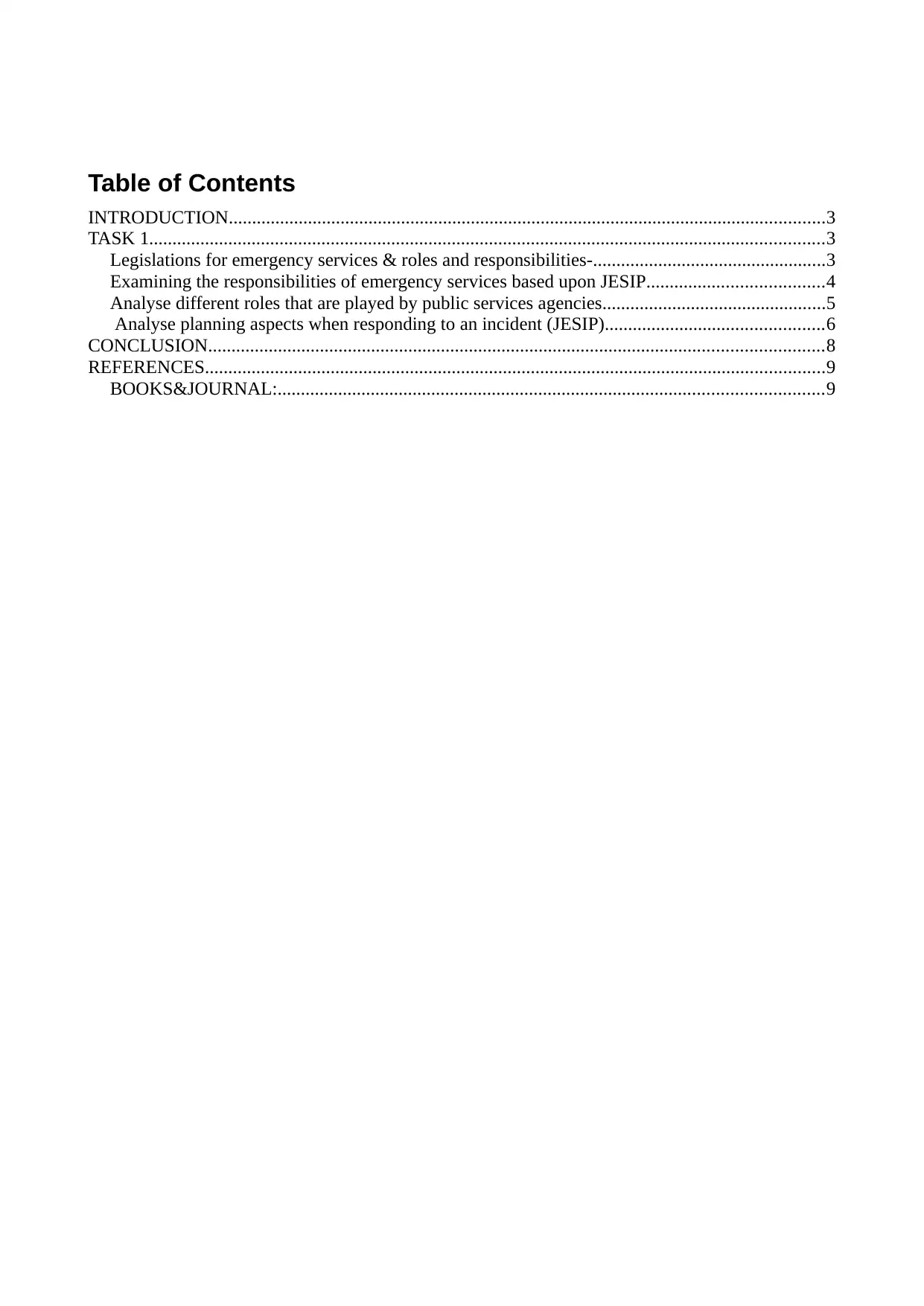
Table of Contents
INTRODUCTION................................................................................................................................3
TASK 1.................................................................................................................................................3
Legislations for emergency services & roles and responsibilities-..................................................3
Examining the responsibilities of emergency services based upon JESIP......................................4
Analyse different roles that are played by public services agencies................................................5
Analyse planning aspects when responding to an incident (JESIP)...............................................6
CONCLUSION....................................................................................................................................8
REFERENCES.....................................................................................................................................9
BOOKS&JOURNAL:.....................................................................................................................9
INTRODUCTION................................................................................................................................3
TASK 1.................................................................................................................................................3
Legislations for emergency services & roles and responsibilities-..................................................3
Examining the responsibilities of emergency services based upon JESIP......................................4
Analyse different roles that are played by public services agencies................................................5
Analyse planning aspects when responding to an incident (JESIP)...............................................6
CONCLUSION....................................................................................................................................8
REFERENCES.....................................................................................................................................9
BOOKS&JOURNAL:.....................................................................................................................9
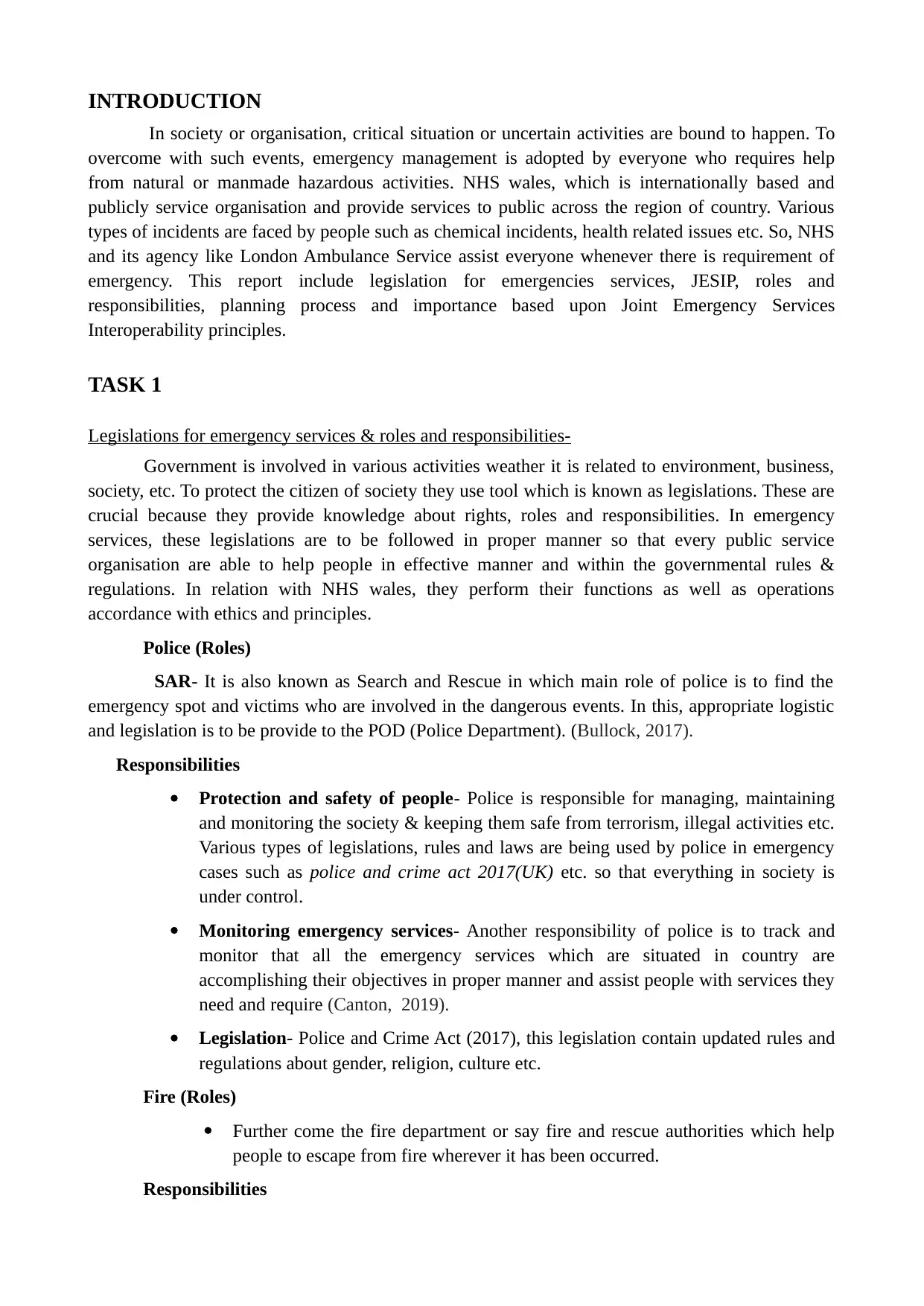
INTRODUCTION
In society or organisation, critical situation or uncertain activities are bound to happen. To
overcome with such events, emergency management is adopted by everyone who requires help
from natural or manmade hazardous activities. NHS wales, which is internationally based and
publicly service organisation and provide services to public across the region of country. Various
types of incidents are faced by people such as chemical incidents, health related issues etc. So, NHS
and its agency like London Ambulance Service assist everyone whenever there is requirement of
emergency. This report include legislation for emergencies services, JESIP, roles and
responsibilities, planning process and importance based upon Joint Emergency Services
Interoperability principles.
TASK 1
Legislations for emergency services & roles and responsibilities-
Government is involved in various activities weather it is related to environment, business,
society, etc. To protect the citizen of society they use tool which is known as legislations. These are
crucial because they provide knowledge about rights, roles and responsibilities. In emergency
services, these legislations are to be followed in proper manner so that every public service
organisation are able to help people in effective manner and within the governmental rules &
regulations. In relation with NHS wales, they perform their functions as well as operations
accordance with ethics and principles.
Police (Roles)
SAR- It is also known as Search and Rescue in which main role of police is to find the
emergency spot and victims who are involved in the dangerous events. In this, appropriate logistic
and legislation is to be provide to the POD (Police Department). (Bullock, 2017).
Responsibilities
Protection and safety of people- Police is responsible for managing, maintaining
and monitoring the society & keeping them safe from terrorism, illegal activities etc.
Various types of legislations, rules and laws are being used by police in emergency
cases such as police and crime act 2017(UK) etc. so that everything in society is
under control.
Monitoring emergency services- Another responsibility of police is to track and
monitor that all the emergency services which are situated in country are
accomplishing their objectives in proper manner and assist people with services they
need and require (Canton, 2019).
Legislation- Police and Crime Act (2017), this legislation contain updated rules and
regulations about gender, religion, culture etc.
Fire (Roles)
Further come the fire department or say fire and rescue authorities which help
people to escape from fire wherever it has been occurred.
Responsibilities
In society or organisation, critical situation or uncertain activities are bound to happen. To
overcome with such events, emergency management is adopted by everyone who requires help
from natural or manmade hazardous activities. NHS wales, which is internationally based and
publicly service organisation and provide services to public across the region of country. Various
types of incidents are faced by people such as chemical incidents, health related issues etc. So, NHS
and its agency like London Ambulance Service assist everyone whenever there is requirement of
emergency. This report include legislation for emergencies services, JESIP, roles and
responsibilities, planning process and importance based upon Joint Emergency Services
Interoperability principles.
TASK 1
Legislations for emergency services & roles and responsibilities-
Government is involved in various activities weather it is related to environment, business,
society, etc. To protect the citizen of society they use tool which is known as legislations. These are
crucial because they provide knowledge about rights, roles and responsibilities. In emergency
services, these legislations are to be followed in proper manner so that every public service
organisation are able to help people in effective manner and within the governmental rules &
regulations. In relation with NHS wales, they perform their functions as well as operations
accordance with ethics and principles.
Police (Roles)
SAR- It is also known as Search and Rescue in which main role of police is to find the
emergency spot and victims who are involved in the dangerous events. In this, appropriate logistic
and legislation is to be provide to the POD (Police Department). (Bullock, 2017).
Responsibilities
Protection and safety of people- Police is responsible for managing, maintaining
and monitoring the society & keeping them safe from terrorism, illegal activities etc.
Various types of legislations, rules and laws are being used by police in emergency
cases such as police and crime act 2017(UK) etc. so that everything in society is
under control.
Monitoring emergency services- Another responsibility of police is to track and
monitor that all the emergency services which are situated in country are
accomplishing their objectives in proper manner and assist people with services they
need and require (Canton, 2019).
Legislation- Police and Crime Act (2017), this legislation contain updated rules and
regulations about gender, religion, culture etc.
Fire (Roles)
Further come the fire department or say fire and rescue authorities which help
people to escape from fire wherever it has been occurred.
Responsibilities
⊘ This is a preview!⊘
Do you want full access?
Subscribe today to unlock all pages.

Trusted by 1+ million students worldwide
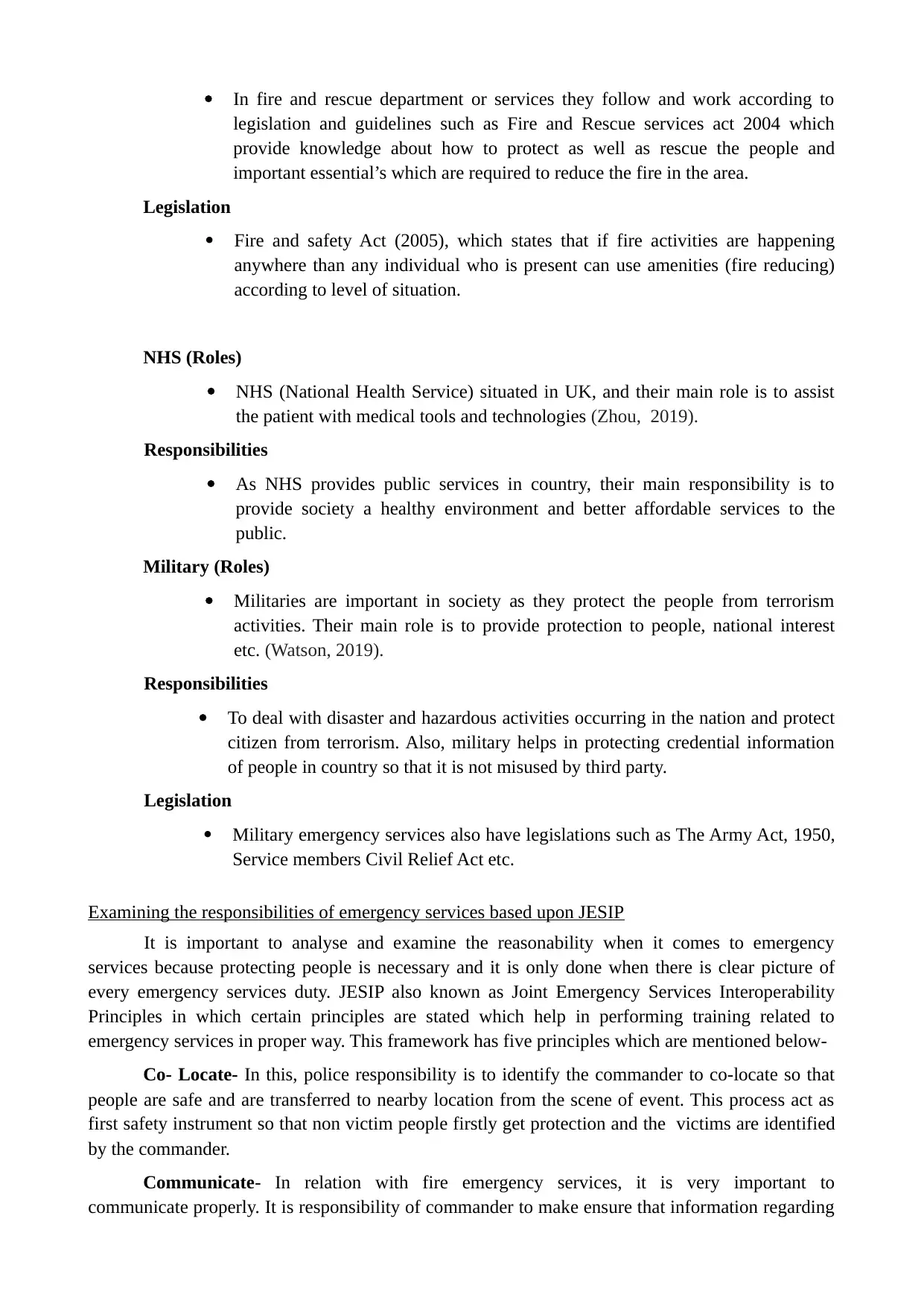
In fire and rescue department or services they follow and work according to
legislation and guidelines such as Fire and Rescue services act 2004 which
provide knowledge about how to protect as well as rescue the people and
important essential’s which are required to reduce the fire in the area.
Legislation
Fire and safety Act (2005), which states that if fire activities are happening
anywhere than any individual who is present can use amenities (fire reducing)
according to level of situation.
NHS (Roles)
NHS (National Health Service) situated in UK, and their main role is to assist
the patient with medical tools and technologies (Zhou, 2019).
Responsibilities
As NHS provides public services in country, their main responsibility is to
provide society a healthy environment and better affordable services to the
public.
Military (Roles)
Militaries are important in society as they protect the people from terrorism
activities. Their main role is to provide protection to people, national interest
etc. (Watson, 2019).
Responsibilities
To deal with disaster and hazardous activities occurring in the nation and protect
citizen from terrorism. Also, military helps in protecting credential information
of people in country so that it is not misused by third party.
Legislation
Military emergency services also have legislations such as The Army Act, 1950,
Service members Civil Relief Act etc.
Examining the responsibilities of emergency services based upon JESIP
It is important to analyse and examine the reasonability when it comes to emergency
services because protecting people is necessary and it is only done when there is clear picture of
every emergency services duty. JESIP also known as Joint Emergency Services Interoperability
Principles in which certain principles are stated which help in performing training related to
emergency services in proper way. This framework has five principles which are mentioned below-
Co- Locate- In this, police responsibility is to identify the commander to co-locate so that
people are safe and are transferred to nearby location from the scene of event. This process act as
first safety instrument so that non victim people firstly get protection and the victims are identified
by the commander.
Communicate- In relation with fire emergency services, it is very important to
communicate properly. It is responsibility of commander to make ensure that information regarding
legislation and guidelines such as Fire and Rescue services act 2004 which
provide knowledge about how to protect as well as rescue the people and
important essential’s which are required to reduce the fire in the area.
Legislation
Fire and safety Act (2005), which states that if fire activities are happening
anywhere than any individual who is present can use amenities (fire reducing)
according to level of situation.
NHS (Roles)
NHS (National Health Service) situated in UK, and their main role is to assist
the patient with medical tools and technologies (Zhou, 2019).
Responsibilities
As NHS provides public services in country, their main responsibility is to
provide society a healthy environment and better affordable services to the
public.
Military (Roles)
Militaries are important in society as they protect the people from terrorism
activities. Their main role is to provide protection to people, national interest
etc. (Watson, 2019).
Responsibilities
To deal with disaster and hazardous activities occurring in the nation and protect
citizen from terrorism. Also, military helps in protecting credential information
of people in country so that it is not misused by third party.
Legislation
Military emergency services also have legislations such as The Army Act, 1950,
Service members Civil Relief Act etc.
Examining the responsibilities of emergency services based upon JESIP
It is important to analyse and examine the reasonability when it comes to emergency
services because protecting people is necessary and it is only done when there is clear picture of
every emergency services duty. JESIP also known as Joint Emergency Services Interoperability
Principles in which certain principles are stated which help in performing training related to
emergency services in proper way. This framework has five principles which are mentioned below-
Co- Locate- In this, police responsibility is to identify the commander to co-locate so that
people are safe and are transferred to nearby location from the scene of event. This process act as
first safety instrument so that non victim people firstly get protection and the victims are identified
by the commander.
Communicate- In relation with fire emergency services, it is very important to
communicate properly. It is responsibility of commander to make ensure that information regarding
Paraphrase This Document
Need a fresh take? Get an instant paraphrase of this document with our AI Paraphraser
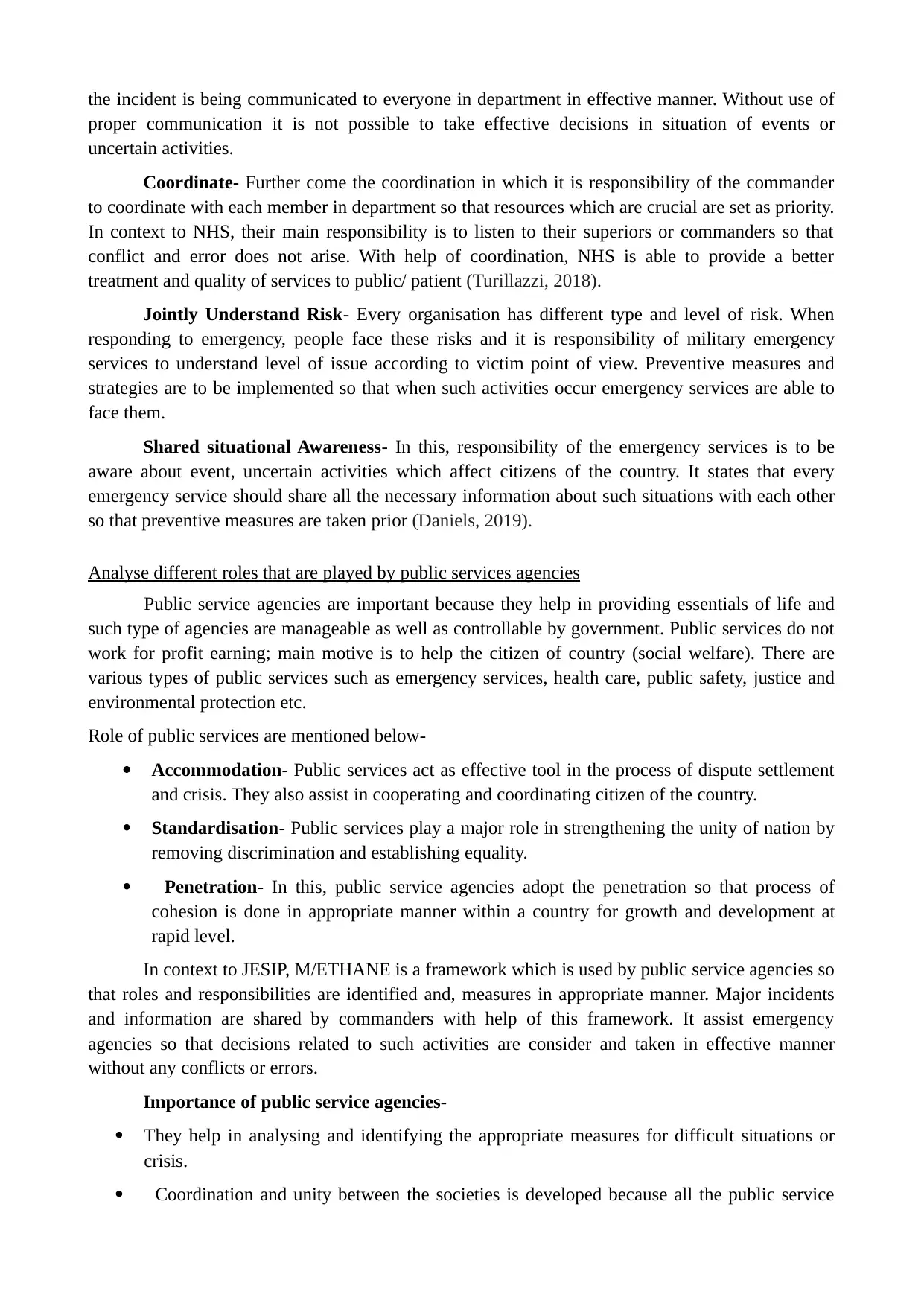
the incident is being communicated to everyone in department in effective manner. Without use of
proper communication it is not possible to take effective decisions in situation of events or
uncertain activities.
Coordinate- Further come the coordination in which it is responsibility of the commander
to coordinate with each member in department so that resources which are crucial are set as priority.
In context to NHS, their main responsibility is to listen to their superiors or commanders so that
conflict and error does not arise. With help of coordination, NHS is able to provide a better
treatment and quality of services to public/ patient (Turillazzi, 2018).
Jointly Understand Risk- Every organisation has different type and level of risk. When
responding to emergency, people face these risks and it is responsibility of military emergency
services to understand level of issue according to victim point of view. Preventive measures and
strategies are to be implemented so that when such activities occur emergency services are able to
face them.
Shared situational Awareness- In this, responsibility of the emergency services is to be
aware about event, uncertain activities which affect citizens of the country. It states that every
emergency service should share all the necessary information about such situations with each other
so that preventive measures are taken prior (Daniels, 2019).
Analyse different roles that are played by public services agencies
Public service agencies are important because they help in providing essentials of life and
such type of agencies are manageable as well as controllable by government. Public services do not
work for profit earning; main motive is to help the citizen of country (social welfare). There are
various types of public services such as emergency services, health care, public safety, justice and
environmental protection etc.
Role of public services are mentioned below-
Accommodation- Public services act as effective tool in the process of dispute settlement
and crisis. They also assist in cooperating and coordinating citizen of the country.
Standardisation- Public services play a major role in strengthening the unity of nation by
removing discrimination and establishing equality.
Penetration- In this, public service agencies adopt the penetration so that process of
cohesion is done in appropriate manner within a country for growth and development at
rapid level.
In context to JESIP, M/ETHANE is a framework which is used by public service agencies so
that roles and responsibilities are identified and, measures in appropriate manner. Major incidents
and information are shared by commanders with help of this framework. It assist emergency
agencies so that decisions related to such activities are consider and taken in effective manner
without any conflicts or errors.
Importance of public service agencies-
They help in analysing and identifying the appropriate measures for difficult situations or
crisis.
Coordination and unity between the societies is developed because all the public service
proper communication it is not possible to take effective decisions in situation of events or
uncertain activities.
Coordinate- Further come the coordination in which it is responsibility of the commander
to coordinate with each member in department so that resources which are crucial are set as priority.
In context to NHS, their main responsibility is to listen to their superiors or commanders so that
conflict and error does not arise. With help of coordination, NHS is able to provide a better
treatment and quality of services to public/ patient (Turillazzi, 2018).
Jointly Understand Risk- Every organisation has different type and level of risk. When
responding to emergency, people face these risks and it is responsibility of military emergency
services to understand level of issue according to victim point of view. Preventive measures and
strategies are to be implemented so that when such activities occur emergency services are able to
face them.
Shared situational Awareness- In this, responsibility of the emergency services is to be
aware about event, uncertain activities which affect citizens of the country. It states that every
emergency service should share all the necessary information about such situations with each other
so that preventive measures are taken prior (Daniels, 2019).
Analyse different roles that are played by public services agencies
Public service agencies are important because they help in providing essentials of life and
such type of agencies are manageable as well as controllable by government. Public services do not
work for profit earning; main motive is to help the citizen of country (social welfare). There are
various types of public services such as emergency services, health care, public safety, justice and
environmental protection etc.
Role of public services are mentioned below-
Accommodation- Public services act as effective tool in the process of dispute settlement
and crisis. They also assist in cooperating and coordinating citizen of the country.
Standardisation- Public services play a major role in strengthening the unity of nation by
removing discrimination and establishing equality.
Penetration- In this, public service agencies adopt the penetration so that process of
cohesion is done in appropriate manner within a country for growth and development at
rapid level.
In context to JESIP, M/ETHANE is a framework which is used by public service agencies so
that roles and responsibilities are identified and, measures in appropriate manner. Major incidents
and information are shared by commanders with help of this framework. It assist emergency
agencies so that decisions related to such activities are consider and taken in effective manner
without any conflicts or errors.
Importance of public service agencies-
They help in analysing and identifying the appropriate measures for difficult situations or
crisis.
Coordination and unity between the societies is developed because all the public service
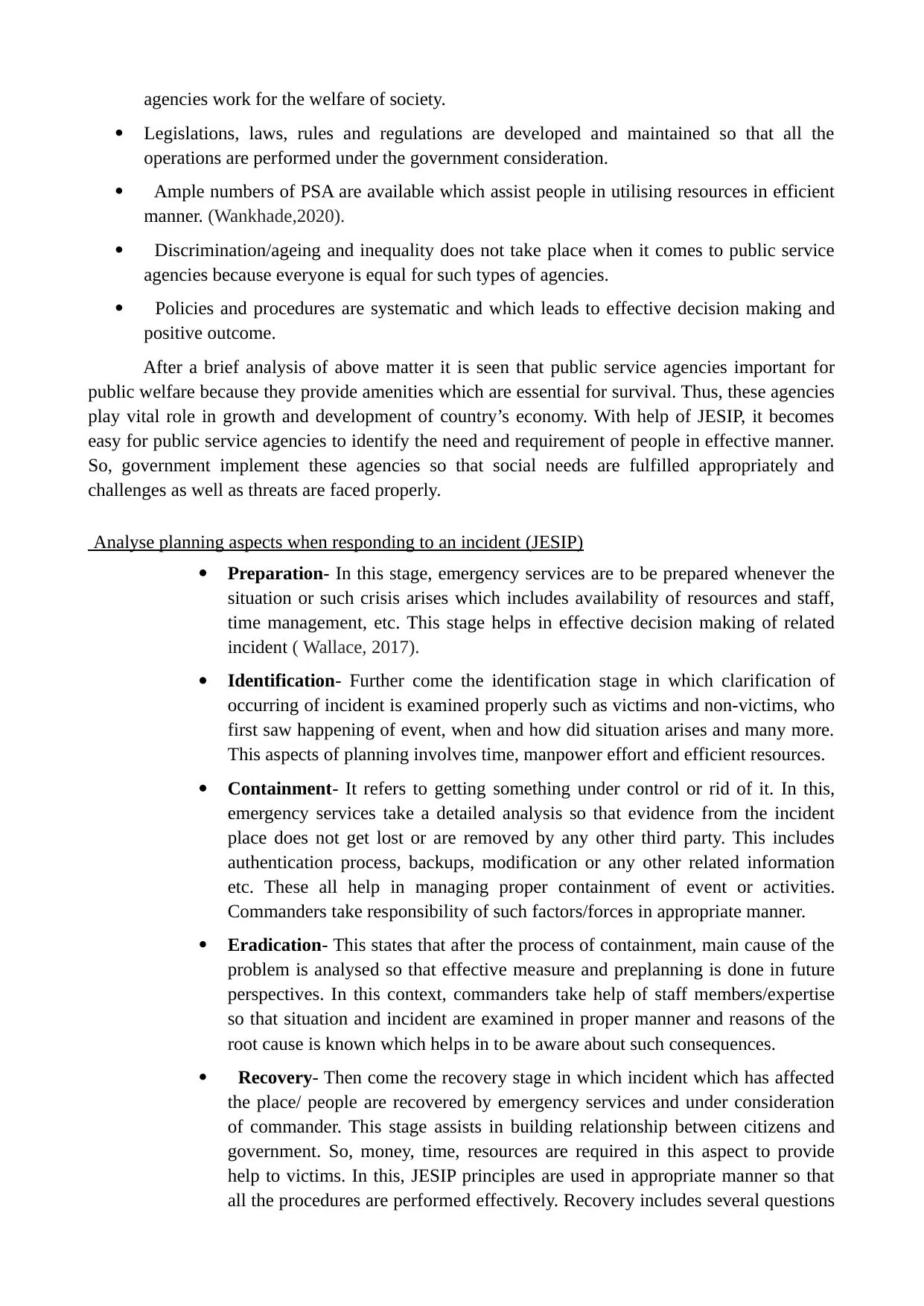
agencies work for the welfare of society.
Legislations, laws, rules and regulations are developed and maintained so that all the
operations are performed under the government consideration.
Ample numbers of PSA are available which assist people in utilising resources in efficient
manner. (Wankhade,2020).
Discrimination/ageing and inequality does not take place when it comes to public service
agencies because everyone is equal for such types of agencies.
Policies and procedures are systematic and which leads to effective decision making and
positive outcome.
After a brief analysis of above matter it is seen that public service agencies important for
public welfare because they provide amenities which are essential for survival. Thus, these agencies
play vital role in growth and development of country’s economy. With help of JESIP, it becomes
easy for public service agencies to identify the need and requirement of people in effective manner.
So, government implement these agencies so that social needs are fulfilled appropriately and
challenges as well as threats are faced properly.
Analyse planning aspects when responding to an incident (JESIP)
Preparation- In this stage, emergency services are to be prepared whenever the
situation or such crisis arises which includes availability of resources and staff,
time management, etc. This stage helps in effective decision making of related
incident ( Wallace, 2017).
Identification- Further come the identification stage in which clarification of
occurring of incident is examined properly such as victims and non-victims, who
first saw happening of event, when and how did situation arises and many more.
This aspects of planning involves time, manpower effort and efficient resources.
Containment- It refers to getting something under control or rid of it. In this,
emergency services take a detailed analysis so that evidence from the incident
place does not get lost or are removed by any other third party. This includes
authentication process, backups, modification or any other related information
etc. These all help in managing proper containment of event or activities.
Commanders take responsibility of such factors/forces in appropriate manner.
Eradication- This states that after the process of containment, main cause of the
problem is analysed so that effective measure and preplanning is done in future
perspectives. In this context, commanders take help of staff members/expertise
so that situation and incident are examined in proper manner and reasons of the
root cause is known which helps in to be aware about such consequences.
Recovery- Then come the recovery stage in which incident which has affected
the place/ people are recovered by emergency services and under consideration
of commander. This stage assists in building relationship between citizens and
government. So, money, time, resources are required in this aspect to provide
help to victims. In this, JESIP principles are used in appropriate manner so that
all the procedures are performed effectively. Recovery includes several questions
Legislations, laws, rules and regulations are developed and maintained so that all the
operations are performed under the government consideration.
Ample numbers of PSA are available which assist people in utilising resources in efficient
manner. (Wankhade,2020).
Discrimination/ageing and inequality does not take place when it comes to public service
agencies because everyone is equal for such types of agencies.
Policies and procedures are systematic and which leads to effective decision making and
positive outcome.
After a brief analysis of above matter it is seen that public service agencies important for
public welfare because they provide amenities which are essential for survival. Thus, these agencies
play vital role in growth and development of country’s economy. With help of JESIP, it becomes
easy for public service agencies to identify the need and requirement of people in effective manner.
So, government implement these agencies so that social needs are fulfilled appropriately and
challenges as well as threats are faced properly.
Analyse planning aspects when responding to an incident (JESIP)
Preparation- In this stage, emergency services are to be prepared whenever the
situation or such crisis arises which includes availability of resources and staff,
time management, etc. This stage helps in effective decision making of related
incident ( Wallace, 2017).
Identification- Further come the identification stage in which clarification of
occurring of incident is examined properly such as victims and non-victims, who
first saw happening of event, when and how did situation arises and many more.
This aspects of planning involves time, manpower effort and efficient resources.
Containment- It refers to getting something under control or rid of it. In this,
emergency services take a detailed analysis so that evidence from the incident
place does not get lost or are removed by any other third party. This includes
authentication process, backups, modification or any other related information
etc. These all help in managing proper containment of event or activities.
Commanders take responsibility of such factors/forces in appropriate manner.
Eradication- This states that after the process of containment, main cause of the
problem is analysed so that effective measure and preplanning is done in future
perspectives. In this context, commanders take help of staff members/expertise
so that situation and incident are examined in proper manner and reasons of the
root cause is known which helps in to be aware about such consequences.
Recovery- Then come the recovery stage in which incident which has affected
the place/ people are recovered by emergency services and under consideration
of commander. This stage assists in building relationship between citizens and
government. So, money, time, resources are required in this aspect to provide
help to victims. In this, JESIP principles are used in appropriate manner so that
all the procedures are performed effectively. Recovery includes several questions
⊘ This is a preview!⊘
Do you want full access?
Subscribe today to unlock all pages.

Trusted by 1+ million students worldwide

such as how much cost it will took to be recover, are there any methods of
recover or not, how long it will help victims.
Lessons- Further come the lesson learned stage in which all the members in the
operation including commanders share their learning experience and thoughts on
the incident. This aspect is most crucial because new ideas are generated by each
and every one. With help of this stage, commanders are able to identify the
strength and weakness of every personnel. (Petervary,2019).
After a brief analysis of above matter it is stated that planning steps are necessary when
responding to incidents. This helps in proper analysing as well as examining the problem and
consequences in effective manner. Staff members knowledge, skills and understanding increases
when everything goes as systematic process (Mitchell, 2019).
recover or not, how long it will help victims.
Lessons- Further come the lesson learned stage in which all the members in the
operation including commanders share their learning experience and thoughts on
the incident. This aspect is most crucial because new ideas are generated by each
and every one. With help of this stage, commanders are able to identify the
strength and weakness of every personnel. (Petervary,2019).
After a brief analysis of above matter it is stated that planning steps are necessary when
responding to incidents. This helps in proper analysing as well as examining the problem and
consequences in effective manner. Staff members knowledge, skills and understanding increases
when everything goes as systematic process (Mitchell, 2019).
Paraphrase This Document
Need a fresh take? Get an instant paraphrase of this document with our AI Paraphraser
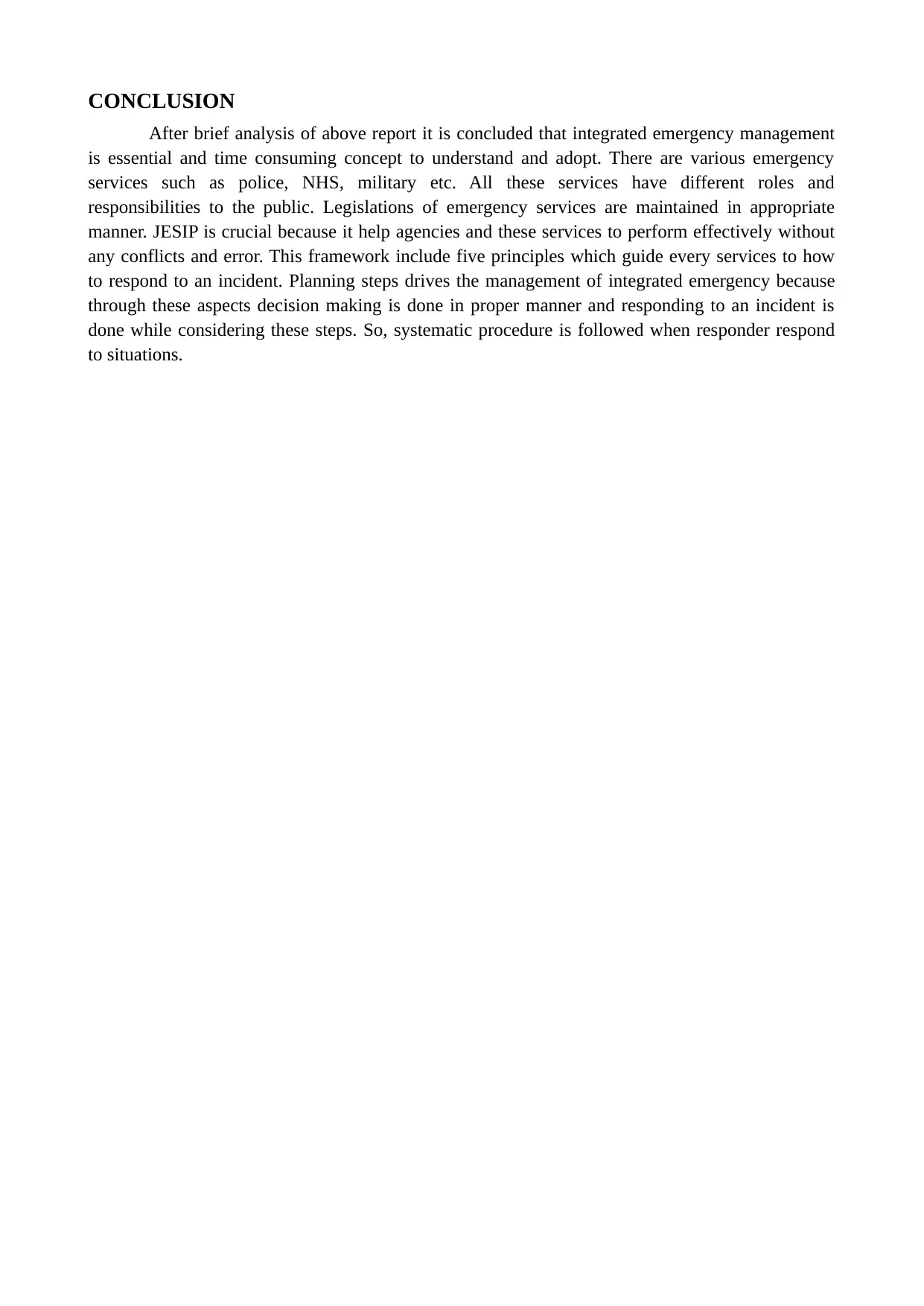
CONCLUSION
After brief analysis of above report it is concluded that integrated emergency management
is essential and time consuming concept to understand and adopt. There are various emergency
services such as police, NHS, military etc. All these services have different roles and
responsibilities to the public. Legislations of emergency services are maintained in appropriate
manner. JESIP is crucial because it help agencies and these services to perform effectively without
any conflicts and error. This framework include five principles which guide every services to how
to respond to an incident. Planning steps drives the management of integrated emergency because
through these aspects decision making is done in proper manner and responding to an incident is
done while considering these steps. So, systematic procedure is followed when responder respond
to situations.
After brief analysis of above report it is concluded that integrated emergency management
is essential and time consuming concept to understand and adopt. There are various emergency
services such as police, NHS, military etc. All these services have different roles and
responsibilities to the public. Legislations of emergency services are maintained in appropriate
manner. JESIP is crucial because it help agencies and these services to perform effectively without
any conflicts and error. This framework include five principles which guide every services to how
to respond to an incident. Planning steps drives the management of integrated emergency because
through these aspects decision making is done in proper manner and responding to an incident is
done while considering these steps. So, systematic procedure is followed when responder respond
to situations.
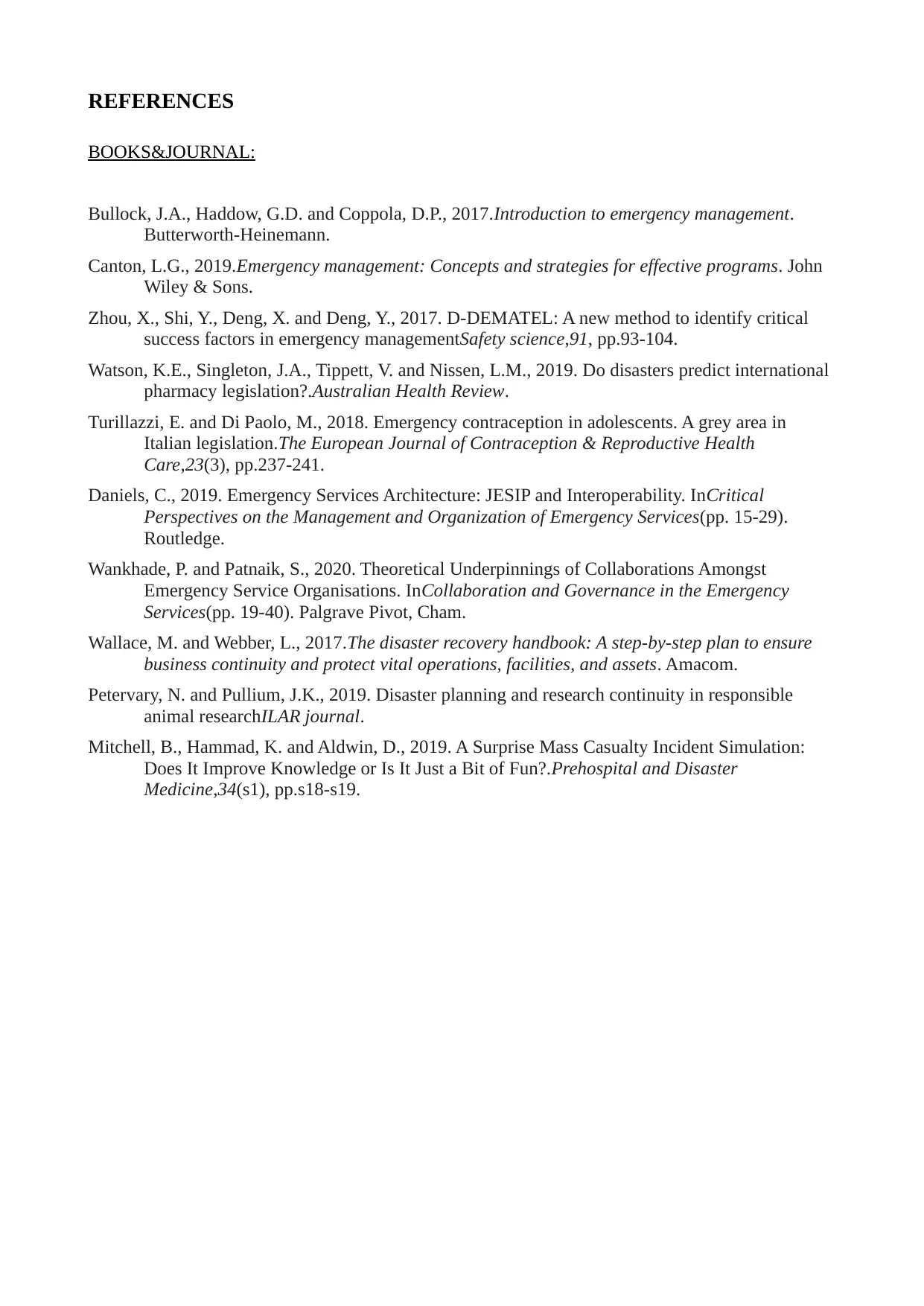
REFERENCES
BOOKS&JOURNAL:
Bullock, J.A., Haddow, G.D. and Coppola, D.P., 2017.Introduction to emergency management.
Butterworth-Heinemann.
Canton, L.G., 2019.Emergency management: Concepts and strategies for effective programs. John
Wiley & Sons.
Zhou, X., Shi, Y., Deng, X. and Deng, Y., 2017. D-DEMATEL: A new method to identify critical
success factors in emergency managementSafety science,91, pp.93-104.
Watson, K.E., Singleton, J.A., Tippett, V. and Nissen, L.M., 2019. Do disasters predict international
pharmacy legislation?.Australian Health Review.
Turillazzi, E. and Di Paolo, M., 2018. Emergency contraception in adolescents. A grey area in
Italian legislation.The European Journal of Contraception & Reproductive Health
Care,23(3), pp.237-241.
Daniels, C., 2019. Emergency Services Architecture: JESIP and Interoperability. InCritical
Perspectives on the Management and Organization of Emergency Services(pp. 15-29).
Routledge.
Wankhade, P. and Patnaik, S., 2020. Theoretical Underpinnings of Collaborations Amongst
Emergency Service Organisations. InCollaboration and Governance in the Emergency
Services(pp. 19-40). Palgrave Pivot, Cham.
Wallace, M. and Webber, L., 2017.The disaster recovery handbook: A step-by-step plan to ensure
business continuity and protect vital operations, facilities, and assets. Amacom.
Petervary, N. and Pullium, J.K., 2019. Disaster planning and research continuity in responsible
animal researchILAR journal.
Mitchell, B., Hammad, K. and Aldwin, D., 2019. A Surprise Mass Casualty Incident Simulation:
Does It Improve Knowledge or Is It Just a Bit of Fun?.Prehospital and Disaster
Medicine,34(s1), pp.s18-s19.
BOOKS&JOURNAL:
Bullock, J.A., Haddow, G.D. and Coppola, D.P., 2017.Introduction to emergency management.
Butterworth-Heinemann.
Canton, L.G., 2019.Emergency management: Concepts and strategies for effective programs. John
Wiley & Sons.
Zhou, X., Shi, Y., Deng, X. and Deng, Y., 2017. D-DEMATEL: A new method to identify critical
success factors in emergency managementSafety science,91, pp.93-104.
Watson, K.E., Singleton, J.A., Tippett, V. and Nissen, L.M., 2019. Do disasters predict international
pharmacy legislation?.Australian Health Review.
Turillazzi, E. and Di Paolo, M., 2018. Emergency contraception in adolescents. A grey area in
Italian legislation.The European Journal of Contraception & Reproductive Health
Care,23(3), pp.237-241.
Daniels, C., 2019. Emergency Services Architecture: JESIP and Interoperability. InCritical
Perspectives on the Management and Organization of Emergency Services(pp. 15-29).
Routledge.
Wankhade, P. and Patnaik, S., 2020. Theoretical Underpinnings of Collaborations Amongst
Emergency Service Organisations. InCollaboration and Governance in the Emergency
Services(pp. 19-40). Palgrave Pivot, Cham.
Wallace, M. and Webber, L., 2017.The disaster recovery handbook: A step-by-step plan to ensure
business continuity and protect vital operations, facilities, and assets. Amacom.
Petervary, N. and Pullium, J.K., 2019. Disaster planning and research continuity in responsible
animal researchILAR journal.
Mitchell, B., Hammad, K. and Aldwin, D., 2019. A Surprise Mass Casualty Incident Simulation:
Does It Improve Knowledge or Is It Just a Bit of Fun?.Prehospital and Disaster
Medicine,34(s1), pp.s18-s19.
⊘ This is a preview!⊘
Do you want full access?
Subscribe today to unlock all pages.

Trusted by 1+ million students worldwide
1 out of 9
Related Documents
Your All-in-One AI-Powered Toolkit for Academic Success.
+13062052269
info@desklib.com
Available 24*7 on WhatsApp / Email
![[object Object]](/_next/static/media/star-bottom.7253800d.svg)
Unlock your academic potential
Copyright © 2020–2025 A2Z Services. All Rights Reserved. Developed and managed by ZUCOL.





